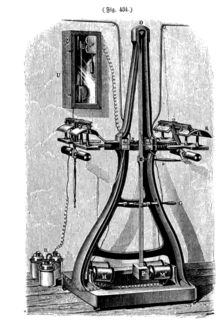

The pantelegraph (French: pantélégraphe) was developed by Giovanni Caselli for commericial use in 1865.[1]
The pantelegraph is a system of sending and receiving images over long distances by means of telegraph wiring. This system was actually the first prototype of a fax machine that was commercially exploited, though the images transmitted by telegraph were reproduced using electrochemistry. Special ferrous ink was used on an electroplated original "document" and transmitted over telegraph wires. It used a system of rotating drums. They were scanned by synchronized pendulums. The sending drum had the electrically charged document. The receiving drum had a chemically soaked special paper sensitive to electricity.[2]
One of the keys is the use of special ferrous ink. That meant it had iron in it, therefore electricity would pass through it. At the "reading" end there was a metal stylus that would pass electricity when it hit the ferrous ink on a swing of the arm. When the stylus did not make contact with the iron ink on a swing there was no electricity passed. When it did come in contact with the iron ink then electricity was passed for that monent. This then was "signals" of on and off electricity that at the receiving end was received through an electrochemistry process of impregnated potassium ferrit cyanide sensitive paper that would make dark marks exactly when it received the electrical on "signals" sent. When it did not receive an electrical signal, then it was an "off" signal and the electrochemistry process did NOT produce dark marks at those times of the swing. As long as the sending mechanism and receiving mechanism were in sync then the image "received" was exactly the image as "read." The trick was to make sure the sending mechanism and receiving mechanism were in sync to get the correct image, otherwise it would come out as a real distorted image nothing like the original. This was done through a timimg clock and adjustments on either or both the sending and receiving mechanisms.[3][4][5]
The pantograph principle used here, which underlies this "pantograph at a distance (Greek tele-)", is based on mechanical linkage working with an electrical network connected in a special manner based on parallelograms so that the movement of one specified point is an electrical and mechanical version of the movement of another point miles away.[6]
Description
The pantelegraph was a 3-meter tall pendulum-based system which from the point-of-origin "read" the plated document with a stylus on each swing. It would need to be in synchronization with its corresponding receiving station; this synchronization was achieved by using a simple electrical pulse or "heartbeat" that was adjusted by electromagnets at either side of the pendulum's swing.
Most common use of the pantelegraph was for signature verification in banking transactions. Pantelegraphs were typically found at railroad stations, where electric lines were used for telegram transmission. Later, these simple two-wire electric lines were the foundation for telephony.
History
French law was enacted then in 1864 for the pantelegraph facsimile system to be officially accepted. The next year in 1865 the operations started with the Paris to Lyon line and extended to Marseille in 1867.[7] This service continued until 1870. The device was used by Napoleon III, and sent over 5000 images in the first year of operation. The use of the pantelegraph was de-commissioned by the French government later that same year.[8]
There are few remaining examples of the original pantelegraph. A formidable display of the pantelegraph was mounted in 1961 at the Musée National des Techniques, when a centennial celebration of the device was performed between Paris and Marseille. Again in 1982 their reliability was displayed; two pantelegraphs were used for six hours a day, for several months, performing without error.
The inventor of the original FAX process was Alexander Bain in 1843, though not for commercial pursuits. Frederick Bakewell demonstrated at the London Great Exhibition of 1851 a working model. [9]
Footnotes
- ^ Anzovin, pp. 425-426 #5874
- ^ Anzovin, p. 426 #5874
- ^ Huurdeman, p. 147
- ^ The Secret Life of the Fax Machine
- ^ 3 part series of how FAX machines work
- ^ Communications By R. W. Burns, Institution of Electrical Engineers, Chapter 8, pp. 207-225
- ^ Huurdeman, p. 150 This test was also successful, so that the pantelegraph became accepted for use on the French telegraph network by law on April 24, 1864. Official operation started on the Paris-Lyon line on February 16, 1865 and was extended to Marseille in 1867.
- ^ Sarkar, p. 67 Italian physicist Giovanni Caselli built a machine to send and receive images over long distances using telegraph that he called pantelegraph. It was used by the French Post/Telegraph agency between Paris and Marseille from 1867 to 1870.
- ^ Anzovin, p. 425 #5873
References
- Anzovin, Steven et al, Famous first facts, international edition: a record of first happenings, discoveries, and inventions in world history, H. W. Wilson Company, ISBN 0-8242-0958-3
- Huurdeman, Anton A., The worldwide history of telecommunications, Wiley-IEEE, 2003, ISBN 0-4712050-5-2
- Sarkar, Tapan K. et al., History of wireless, John Wiley and Sons, 2006, ISBN 0-4717181-4-9
External links
- Giovanni Caselli, by Eugenii Katz. Internet Archive version.
- Facsimile & SSTV History – this site has lots of images
- Secret Life of The Fax Machine - Illustrated History by Cartoonist Tim Hunkin